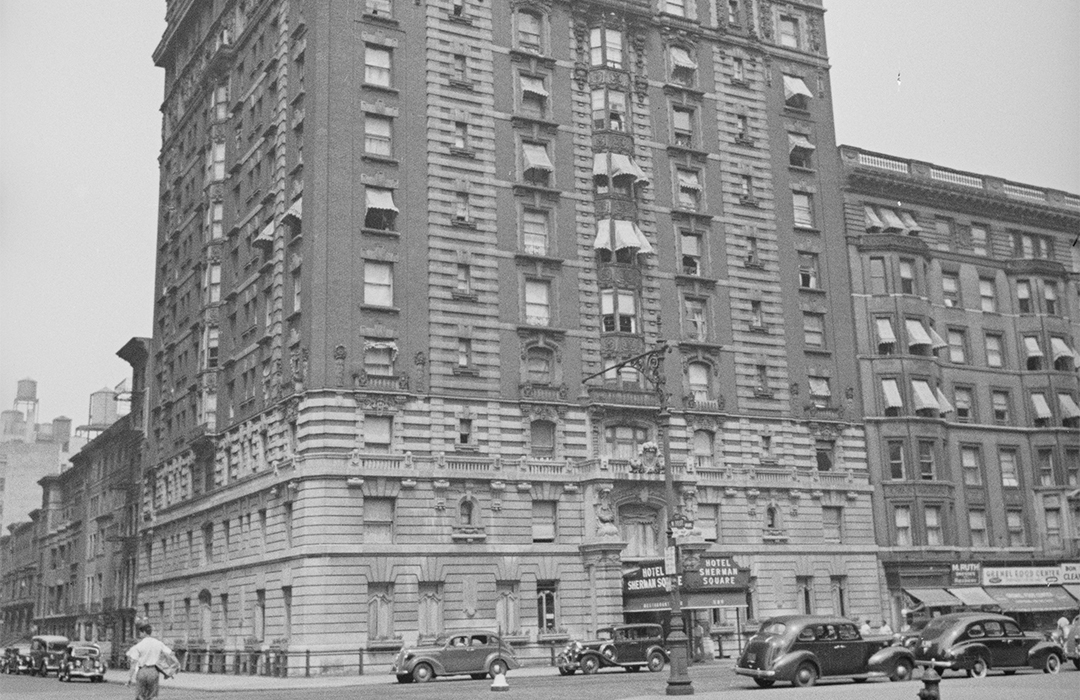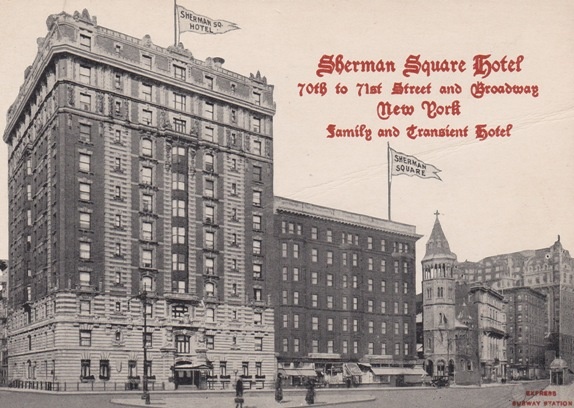
The Sherman Square Hotel
by Tom Miller
In 1893 architect Ralph S. Townsend designed the seven-story Sherman Square Hotel at the southwest corner of Broadway and 71st Street. Costing the equivalent of $14 million in 2024 money, its brick-and-stone façade undulated with full-height projecting bays and a stone balustrade crowned its cornice. It faced competition in February 1902, when the Seaboard Realty Co. purchased the vacant property at the northwest corner of 70th Street. Two months later, the Record & Guide reported that architect Harry B. Mulliken had nearly completed plans “for a twelve-story brick and stone hotel apartment house.” Rising above the Sherman Square Hotel, the Hotel Regent’s Beaux Arts design featured a two-story stone base, above which red brick and white limestone were lavished with French style decorations.
The well-to-do residents of the Hotel Regent were rattled when, on the night of December 20, 1903, an accumulation of gas in the subway exploded under the southwest corner of 70th Street and Amsterdam Avenue. The New York Times reported that a manhole cover “was torn out of the street and lifted into the air a distance of several feet. The pavement for a space of twenty feet square was ripped up, and stones and gravel were sent flying in all directions.” The newspaper said that “when the stones and the manhole casting fell back to the street,” at least one pedestrian thought the explosion had occurred in the new Hotel Regent.
The two side-by-side residential hotels would not be in competition for long. In September 1904, The Hotel Monthly reported, “Frank M. Rogers is principal stockholder and manager of the Hotel Regent Co., which has leased the Sherman Square Hotel, New York. Hotel Regent and the Sherman Square will be combined.” In fact, the physical joining of the two dissimilar structures did not happen for another five years.
The two side-by-side residential hotels would not be in competition for long.
On September 4, 1909, the Record & Guide reported, “The merging of two large hotels does not frequently occur. But this is what happened during the week when the Sherman Square purchased the adjoining Regent for a reported consideration of $900,000.” The article said the two structures would be combined internally at a cost of “some $150,000.” The total investment would translate to a staggering $36 million today. Harry B. Mulliken was brought back to design the alterations. The merged hotel would accommodate 50 families in total. A notice in The Sun on September 6, 1909, announced, “Sherman Square Hotel and Hotel Regent [are] now under the efficient management of the Sherman Square Hotel and will hereafter the known as the Sherman Square Hotel.”
The Sherman Square Hotel catered to upscale families. Living in the former Hotel Regent section in 1910 was the Hardcastle family. Just before noon on June 17, Edith Hardcastle told her mother she was going out shopping. The New York Times reported, “In twenty minutes word reached the hotel that she as in the police station.” Edith had gone into the subway station at 72nd Street and when the southbound train approached the platform, she flung herself onto the tracks. The motorman, H. E. Bleecker had tried to stop the train, but it was too late, and two cars passed over her. Astoundingly, when Bleecker and the conductor, Thomas Meehan, jumped from the train, they did not find a mangled corpse as they expected. The New York Times said, “she was lying, face downward, between the rails under the third car, not in the least injured.” The article said, “She was handsomely dressed in a tan pongee suit, with a straw hat and a black veil.”
Edith was taken to the West 68th Street police station and word was sent to her family. When asked why she had attempted suicide, she replied, “I don’t know. I must have been silly.” Edith’s brother first appeared at the station, followed by his father. The Times said Hardcastle was “in a very agitated frame of mind,” adding, “He is an importer.” Attempted suicide was a jailable offense, and so Edith’s father appeared with her before Magistrate Harris in the West 54th Street Court that afternoon. Harris “advised him to put her at once under the care of a physician,” said the newspaper, to which Hardcastle “replied that he would send her on a trip to Europe immediately.”
A prominent resident of the Sherman Square Hotel was James W. Osborne, described by the New-York Tribune as “one of the best known criminal lawyers in the city and the leading legal figure in several sensational murder cases while he was an Assistant District Attorney.” Born in 1859, he married Leila Grey Van Wyck, the daughter of former Supreme Court Justice Augustus Van Wyck, in 1896. The couple had an adult son, James Jr.
In 1914, Osborne began suffering “occasional attacks of acute indigestion,” according to the New-York Tribune, “but he was in fairly good health.” His doctor advised him to exercise, so he frequently played tennis at the West Side Tennis Club at Forest Hills, Long Island.
Leila Osborne’s mother died in 1919, and she began dividing her time between the Osborne apartment and the apartment of her father in the Marie Antoinette Hotel. She was there on September 6, 1919, when her husband and son went to Forest Hills to play tennis. There they “played several strenuous sets.” The younger Osborne left at 7:00 while his father “remained at the tennis club to watch the last matches between the American and Australian players,” said the New-York Tribune.
A rundown hotel at Amsterdam Avenue and 71st Street around which narcotics addicts, pimps, prostitutes and other disreputable persons often loiter at night, will be torn down to make was for a luxury apartment house more than 30 stores high.”
Since his wife would not be coming home that night, Osborne spent time in the Manhattan Chess Club rooms in the Sherman Square Hotel, then at 11:00 p.m., “went out and ate a heavy meal, his first since breakfast.” The next day, shortly after noon, James Osborne Jr. entered the apartment with his own key. “Receiving no reply to his greeting, he walked to his father’s bedside and found him dead.” His sudden death prompted large headlines and extensive articles in the local newspapers.
When the newly formed Incorporated Real Properties purchased the Sherman Square Hotel in June 1951, The New York Times remarked, “It has been under management of John E. Connelly since 1904 and at the turn of the century was a gathering place for celebrities.” The unlikely co-joined structures survived for just sixteen years—albeit not the proud residences they had once been.
On December 1, 1967, The New York Times reported, “A rundown hotel at Amsterdam Avenue and 71st Street around which narcotics addicts, pimps, prostitutes and other disreputable persons often loiter at night, will be torn down to make was for a luxury apartment house more than 30 stores high.” The article said the sale of the Sherman Square the previous day had been the result of efforts by “real-estate men and spirited young couples, many with small children, to drive out elements responsible for recent muggings and other crimes.” The vintage buildings were demolished to make way for a 41-story apartment house, completed in 1971.
Tom Miller is a social historian and blogger at daytoninmanhattan.blogspot.com
BUILDING DATABASE
Keep Exploring
Be a part of history!
Think Local First to support the businesses at 2039-2049 Broadway:
Meet FDNY Chief Frank Montagna!
Meet Howard Schultz!
Meet Francisco Gaviña & Leonor Gaviña Valls!



